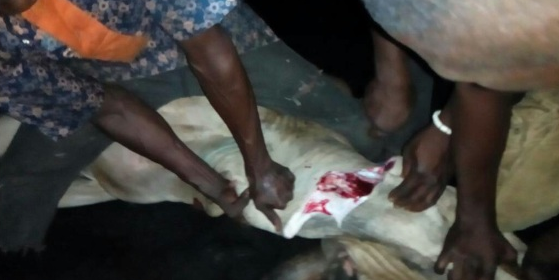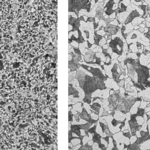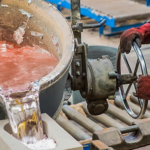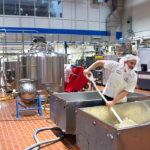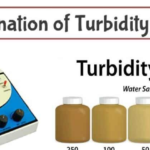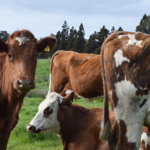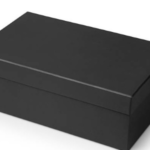Introduction
An abattoir is also called a slaughterhouse. It is a facility where animals are slaughtered for consumption as food. Slaughtering animals on a large scale poses significant logistical problems, animal welfare problems, public health requirements, and environmental problems. Thus, the determination of where to build a slaughterhouse is a decision that must be carefully made. In Nigeria, abattoirs are usually constructed at sides of running rivers where the wastes can be easily washed away.
The case study of this research is an abattoir located at Sabo (atenda), Ikire Osun state, Nigeria. In the abattoir, on the average, 4-5 cows are slaughtered per day, and slaughtering takes place every day except on Sundays. Also, at this abattoir there was no presence of any modern equipments. The only available equipments are very sharp knives used for the slaughtering of animals.

Pre-Slaughtering Process
• The animals to be slaughtered were bought from the market a day before the slaughtering day.
• Ante mortem inspection was carried out on the animals before buying them from market
• The animals were allowed to rest before the slaughtering day to limit stress on the animals and ensure the slaughtering of healthy cows.
• Also, the cows were fed with grass and very clean water.
Slaughtering Procedures
At this abattoir, the method used for the slaughtering is called Stunning Method. Stunning involves cutting the major blood vessel in major throat so that the animal bleeds to death. The processes are highlighted below.
1. Exsanguination:
The animal was dragged out of the lairage, restrained by rope on the horns, and at the slaughter spot, the animal was made to fall and the horn pinned to the ground on a spread of fresh grass with head facing up and sharp knife was used to cut the throat. The blood was collected into buckets; as it is used as blood-meal to feed fishes. The horns were also cut as they are sold for other purposes like musical instruments or decorations. The process is shown in Figure 2.

2. Singeing:
The cow was burnt well to remove the hair on the skin of the cows. Singeing is by using a burner to remove the hair on the skin of the animal. Kerosene was poured on the slaughtered animal and lit to burn to off the skin, when the fire was out, scraping knives were used to remove the burnt skin and check whether it was done. The process is shown in Figure 3.
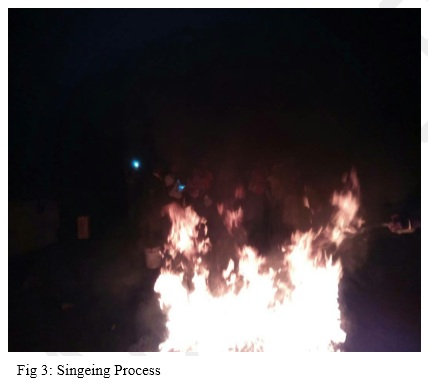
3. Washing and Dissection:
The body was then carried to a concrete floor where it was washed with detergent and sponges; well water was the source of water for the washing process. After washing, the slaughtered cattle was dissected from the midpoint and cut into 4 parts, revealing the inner parts. The inner part consisting the intestine was brought out and every compartment were assessed; the rumen reticulum, omasum, abomasum, heart, kidney, blood vessel, large intestine etc. These were removed one after the other, poured in a bucket of water, rinsed off the dungs and waste products. The process is shown in Figure 4.
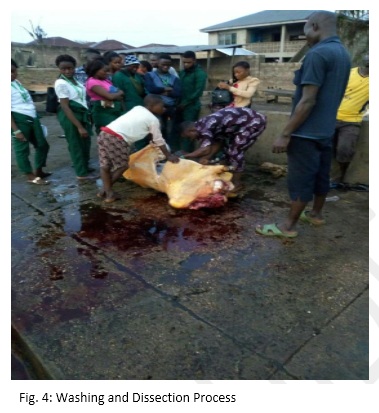
After-Slaughtering Process
After slaughtering, two processes were carried out, namely:
1. Inspection
2. Marketing
Inspection
Post Mortem:
Post mortem was not carried out at the abattoir. The Post mortem is activities carried out on the animal carcasses. It involves visual observation and incision i.e. looking out for abnormalities, and lesions. They are concerned more with zoonotic diseases (diseases that can be transferred to man)
When lesions are seen on some part of the animal, the part is trimmed off.
Disease that can lead to total condemnation of the animal;
- Virulosis (Liver fluid disease) Generalized T.B in modular lesions on the vital organs of the animal.
- Anthrax
- Contagious Bovine Pluero Pneumonia (CBPP)
- Respiratory disease in the lung
Marketing Process
Marketing:
Marketing is the process of selling products. Concerning the market distribution, the abattoir has a ready-made market where the carcasses are being sold. Also people come around to buy different parts of the cattle for resale.
Discussions
Sanitary Measures
Sanitary measures include:
1. Clean source of water.
2. Cleaners that sweep and wash the place.
3. Proper disposal of waste products.
4. Herbicides are also used in the area.
5. Use of disinfectants.
Significant Questions And Answers
1. How many cattle are being slaughtered?
Answer: Four (4).
2. Source of water?
Answer: Well water.
3. Method of slaughtering?
Answer: Stunning method.
4. How is their dung disposed?
Answer: They are disposed properly.
5. How are their bloods disposed?
Answer: The blood were disposed properly.
6. How are their internal organs disposed?
Answer: They are been sold for consumption.
7. How are they cut?
Answer: The part of the animal cut first was the head, followed by the legs and the chest.
8. Preservative method?
Answer: Freezing.
9. Is the slab been taking care of?
Answer: yes.
10. How do they market?
Answer: They were been sold to the buyers.
11. Where do they get the animal?
Answer: The animals where bought from the Fulanis.
12. Who slaughtered the cattle?
Answer: The personnel present in the Abattoir.
13. Do they have any form of after sales storage?
Answer: Yes, freezing.
14. What part do they cut first after removing the head?
Answer: The legs, and then the chest.
15. How is the waste product disposed?
Answer: Fish farmers do come for the waste product for the production of maggot.
16. Why do they do post mortem and ante mortem inspection?
Answer: to prevent slaughtering of pregnant animal and to also prevent eating of carcass affected with Zoonotic disease.
17. Do they have a target market?
Answer: Yes.
18. Do they have any conveying vehicle?
Answer: No.
19. Are there maggot on the slab?
Answer: No.
20. Is good hygiene practiced?
Answer: yes.
21. What do they do with their bones and blood?
Answer: the blood were sold for fish feed while the bones too where burnt and sold
22. Where do they house the cattle before slaughtering?
Answer: lairage.
Challenges Facing the Abattoir
The challenges facing the abattoir include:
1. Waste of time and human drudgery: The method of slaughtering in this abattoir wastes time and makes the people tired because, there are times the animal becomes aggressive and they have to employ various tactics to kill the animal, thereby wasting time and stressing the butchers.
2. Financing: There is no source of finance in the abattoir; individuals don’t get money to buy cattle in the abattoir, no refrigerators in the abattoir for preserving the after sale meat. Someone else deep freezer are used for freezing.
3. Grazing: There is no pasture for the animals to graze; they have to get the feed for the animals most times.
4. Transportation of processed meat: There are no transport facilities such as cool van to transport the meat.
5. Office Space: Absence of an office for administration and effective control of the abattoir.
6. Health facilities: In case of accidents and injuries, there is no health care infrastructure.
7. Proper housing for animals: There is no proper housing for the animals, thus exposing the animals to various dangers.
8. Veterinarians: There are no stationed veterinarians in the abattoir.
Challenges Facing the Abattoir
The government can be of help in providing:
1. Machines and materials that would reduce the time spent in slaughtering cows
2. A loan facilities to the abattoirs
3. An area of land for the animals to graze.
4. Provide basic amenities.
5. Provide social and health amenities for the local abattoirs.
6. Compel the butchers to be in their uniforms.
7. Make available veterinary officers for the local abattoir.
Conclusion
It can be concluded that the method of slaughtering the animals is questionable, and a more advanced, less painful method needs to be adopted. Furthermore, the Abbatoir workers might need to undergo some education on the careful handling of animals before and during slaughter.
